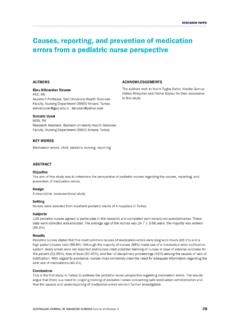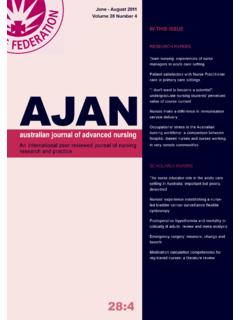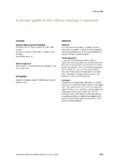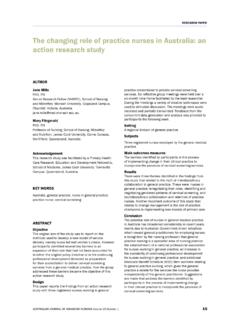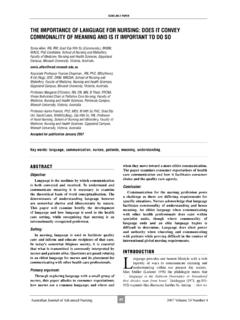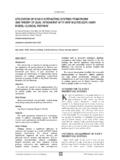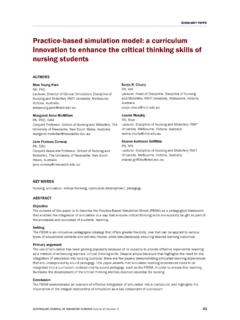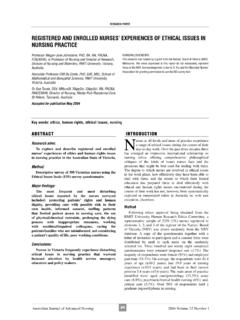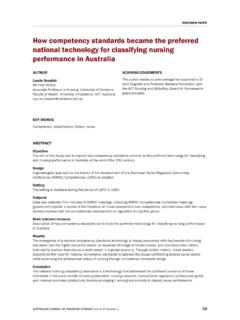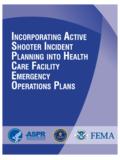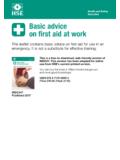Transcription of Working in an overcrowded accident and emergency ...
1 AUSTRALIAN JOURNAL OF ADVANCED NURSING Volume 25 Number 2 Working in an overcrowded accident and emergency department : nurses' narrativesAUTHORSMary (Advanced Nursing Practice), RGN, Higher Dip (AandE) Clinical Nurse Manager, Mayo General Hospital, Castlebar, County Mayo, IrelandMaura DowlingPhD, MSc (Nursing), BNS, RNT, RGN, RM, Cert. Oncology Lecturer, School of Nursing and Midwifery, National University of Ireland, Galway, Ireland WORDS accident and emergency , overcrowding, access block, burn out, caring, powerlessnessABSTRACTAimThe aim of this study was to highlight nursing issues associated with overcrowding (or access block) in the accident and emergency (A&E) interpretive phenomenological approach was adopted, with the utilisation of unstructured A&E department of a general hospital situated in the West of nurses Working in the A&E department volunteered to be central themes, with inter related sub themes, emerged from the data.
2 The central themes identified were: lack of space, elusive care, and powerlessness, with sub themes being health and safety issues, infection control issues, poor service delivery, lack of respect/dignity, nurses hovering, unmet basic human needs, not feeling valued, moral distress, and nurses in this study provide a distressing picture of nursing in an A&E department , as they pursue the provision of effective, holistic care of patients in overcrowded PAPERAUSTRALIAN JOURNAL OF ADVANCED NURSING Volume 25 Number 2 INTRODUCTIONO vercrowding and its associated problems have been highlighted since the late 1980s (Ardagh and Richardson 2004). The problem reflects an international trend, with commentary from Ireland ( department of Health and Children 2005), New Zealand (Richardson et al 2002), United States (Trzeciak and Rivers 2003), Canada (CAEP and NENA 2001), and Australia (Fatovich 2002).
3 overcrowded emergency departments are portrayed as a high risk environment for medical errors and pose a threat for patient safety (Gorden et al 2001). In an effort to manage overcrowding, the Irish Health Service Executive recommends that no patient is to wait for more than 24 hours in an A&E department for admission; no A&E department is to have more than 10 patients waiting for admission; and while awaiting admission, patients will be guaranteed privacy and dignity (Health Service Executive 2006). In Australia, Fatovich et al (2005) reported that improving inpatient flow is the most likely intervention to directly reduce access block. Access block refers to the situation where patients in the emergency department (ED) requiring inpatient care are unable to gain access to appropriate hospital beds within a reasonable time frame (Fatovich et al 2005 ).
4 Specific measures aimed at addressing the issue of overcrowding in A&E departments have proven successful in the United Kingdom. In 2002, Sir George Alberti was appointed as National Clinical Director for emergency Access, and given the responsibility for overseeing the implementation of the Reforming emergency Care strategy. The Reforming emergency Care strategy aim is that the patient s experience of emergency care is represented by shor ter waiting times, with few if any waiting more than four hours from A&E arrival to admission, transfer or discharge; quicker ambulance response times with better training and equipment; more primary care based services for minor ailments; and finally, better integration within emergency and critical care (Hughes 2004). Others, too, report some success in projects to manage operational delays in emergency departments (Bartlett et al 2002).
5 METHODOLOGY AND METHODSThe philosophical views of Heidegger provided guidance for the study s methodology. Research guided by Heideggerian phenomenology is focused on ontological issues about what it means to be a person (Walters 1995). A purposive sample of 11 A&E nurses Working in the A&E department of a regional hospital in the West of Ireland, participated in the study. The nurses had between two and 20 years experience of emergency nursing, and all grades of staff were included to obtain rich data. Approval was sought and granted from the hospital s ethics committee to undertake the study. Recruitment of participants was achieved through displaying an information leaflet on the nursing notice board in the A&E department , explaining study details, and requesting volunteers willing to be interviewed to contact the first author. Because the first author was well known to nurses in the department , a concern was the possibility that nurses might feel obliged to agree to be interviewed if they were approached.
6 Therefore the volunteering approach was deemed appropriate. All eleven participants provided written sampling decisions were purposive, that is, the selection of participants was made on the basis of their ability to provide significant data about the area under inquiry. However it was decided to also interview three nurses who had recently left the A&E department . These three nurses all volunteered at the beginning of the study, but it was initially decided against including them in data collection since they had already left the department . However, data emerging during the early interviews revealed that overcrowding in the A&E department had contributed to the attrition of A&E nurses in other hospitals. Therefore it was decided to include these three participants based on their experience of emergency nursing and to explore if overcrowding was a contributing factor in their decision to leave the A&E department .
7 Evidence of the qualitative RESEARCH PAPERAUSTRALIAN JOURNAL OF ADVANCED NURSING Volume 25 Number 2 researcher as bricoleur is therefore also evident in the study. According to Weinstein and Weinstein (1991), ..the bricoleur is practical and gets the job done ( ). Moreover, it is argued that the notion of researcher as a bricoleur may be a way of enlarging the landscape of the researcher s inquiry, offering a deeper and more comprehensive picture (Tobin and Begley 2004).It was decided to use unstructured interviews, since the research method for this study is in keeping with the views of Heiddeger and his position that the method should be uniquely suited to the particular question (Racher 2003). The first author conducted all the interviews and posed the following opening question to the study participants: Can you tell me how you experience nursing in an overcrowded A&E department ?
8 With regard to the study s dependability, narrative studies do not have formal methods of reliability (Polkinghorne 1988). Instead, they rely on the details of their procedures for procuring the best possible information, which evokes a sense of trustworthiness for the validity of the information used for study (Eberhart and Pieper 1994 ). Credibility was pursued by the first author maintaining a journal of experiences during interviewing and data analysis. Moreover each study participant was asked to confirm the interpreted findings. In addition, an external peer review was obtained from an experienced nurse researcher, based in New Zealand, with extensive emergency nursing experience, who validated the study s (1978) framework of seven procedural steps was used in the data analysis. Although some authors suggest this framework is usually used in descriptive phenomenology (Cohen and Omery 1994), this framework is also suitable for a study utilising a Heideggerian phenomenological framework (Flemming et al 2003).
9 FINDINGST hree themes with sub themes emerged from the nurses narratives (table 1). The nurses narratives revealed that these themes overlapped and impacted reciprocally on each : Themes and sub themes arising from nurses narrativesThemesLack of spaceElusive carePowerlessnessSub themesPoor service deliveryHealth and safetyInfection control issuesLack of respect/dignityUnmet basic human needsHoveringNot feeling valuedMoral distressStress/burnoutstays, we try and accommodate them in the minor department , which therefore leaves us with reduced space for the doctors to see their patients which in turn causes longer delays for the patients that are Also we feel when the emergencies come in, sometimes number one their route is blocked, their actual way in to get into the department sometimes can be blocked because trolleys are put in every conceivable space available.
10 The emergency department is not designed nor has the facilities to nurse patients for long periods Theme: Lack of spaceAll the study participants clearly reflected lack of space in the emergency department , as a major obstacle to service delivery, patient care, health and safety, and infection control. This is clearly articulated in the narrative of Nurse (4) 4: The building wasn t designed when it was planned however many years ago; it wasn t designed to cater for people on trolleys. It was designed as a Working Casualty department with a minor and a majors area, and as it happens all our overnight RESEARCH PAPERAUSTRALIAN JOURNAL OF ADVANCED NURSING Volume 25 Number 2 of time. The issues of infection control, and health and safety within the emergency department are articulated by Nurse (3).Nurse 3: If you have two or three patients bundled into where there should only be a couple of patients then the facilities are being stretched.
